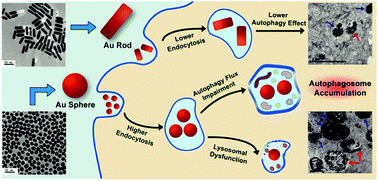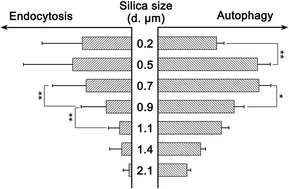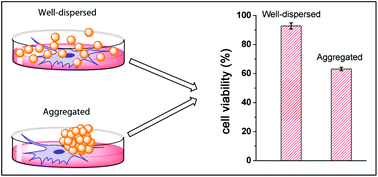Relationship between properties of inorganic nanoparticles and their autophagic effects
Introduction
Many inorganic nanoparticles (INPs) have recently been synthesized and used in the biological research area. It has showed that they likely induce the the autophagic effects and thus lead to a dysfunction of our cellular system, due to their unique physicochemical properties. However, it is still unclear whether these properties (such as size, morphology, surface modification and dispersity) can significantly induce the autophagic effects.
Main findings
In this project, Hualu, as a master graduate student supervised by Professor Jinhao Gao at Xiamen University, synthesized gold, iron oxide, and silica oxide nanoparticles with controllable properties, and generally found that inorganic nanoparticles could modulate autophagic effect by their unique properties, particularly including their dispersity, shape, and size [1].
- Shape
We synthesized the gold nanoparticles with different shapes, and compared their cellular interactions, uptakes, and autophagic effects. The results revealed that gold nanoparticles could modulate autophagy in a shape-dependent manner. Western blot assays and confocal images confirmed that nanospheres caused more autophagosome accumulation than nanorods, which were highly correlated with the difference in cellular uptakes. Please check out the publication [2] for more details.
- Size
We also showed that silica sub-microspheres (0.1 to 2.1 μm in diameter) induced autophagy, which depended on the levels of cellular endocytosis. Due to the suitable size for cellular endocytosis, 0.5–0.7 μm silica particles induced the highest levels of autophagy among particles from 0.1 to 2.1 μm in diameter. Changes in cellular endocytosis of silica sub-microspheres lead to alteration of autophagy levels. Furthermore, dephosphorylation of FOXO3A and subsequent translocation to the nucleus could be associated with this autophagy process. Our results revealed that silica sub-microspheres induced autophagy, and emphasized the potential risk of endocytosis of fine particles or other non-degradable materials. Please check out the publication [3] for more details.
- Dispersity
We selected gold nanoparticles as an example and investigated the role of dispersity in the autophagic effect and a potential cytotoxicity. Our results indicated that the cytotoxicity of aggregated gold nanoparticles is significantly higher than well-dispersed ones. The dispersity-dependent cytotoxicity could be related to the increase of cellular endocytosis and reactive oxygen species. Please check out the publications [4] and [5] for more details.
Publications
[1]. Zhou, H., The characteristics of gold nanoparticles and their cell biological effects, MS thesis, Xiamen University 2017. DOI
[2]. Zhou, H.; Gong, X.; Lin, H.; Chen, H.; Huang, D.; Li, D.; Shan, H.; Gao, J., Gold nanoparticles impair autophagy flux through shape-dependent endocytosis and lysosomal dysfunction. Journal of Materials Chemistry B 2018, 6 (48), 8127-8136. DOI
[3]. Huang, D.; Zhou, H.; Gong, X.; Gao, J., Silica sub-microspheres induce autophagy in an endocytosis dependent manner. RSC Advances 2017, 7 (21), 12496-12502. DOI
[4]. Huang, D.; Zhou, H.; Liu, H.; Gao, J., The cytotoxicity of gold nanoparticles is dispersity-dependent. Dalton Transactions 2015, 44 (41), 17911-17915. DOI
[5]. Huang, D.; Zhou, H.; Gao, J., Nanoparticles modulate autophagic effect in a dispersity-dependent manner. Sci Rep-Uk 2015, 5 (1), 14361. DOI
Presentations
[1]. Zhou, H., Gold nanoparticles impair autophagy flux through shape-dependent endocytosis and lysosomal dysfunction, 2017, Poster Presentation at International Symposium on Nanotechnology & Nanoimpact, Fujian, China.
[2]. Zhou, H., The cytotoxicity of gold nanoparticles is dispersity dependent, 2016, Poster presentation at National Nanotechnology Institution Annual Meeting, Fujian, China.



